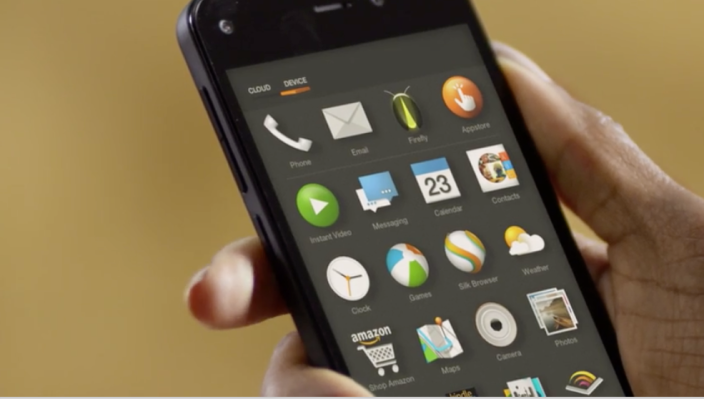
How to use Dynamic Perspective gestures on the Fire phone
by Jason Cipriani @MrCippy
Upon unboxing your shiny new Fire phone, you likely noticed the four small dots, one in each corner, on the face of the device. The dots are where Amazon placed specials cameras that track your face whenever you’re using the Fire. Using four cameras instead of just two ensures that no matter how you hold the device, Dynamic Perspective will be able to track you. By tracking your face, Dynamic Perspective is able to better apply a 3-D effect to the user-interface across the entire device.
Going beyond rotating an app icon or text on the screen, Amazon also integrated gestures to aide in navigating your phone. There are four main gestures you’ll need to learn.
Swivel
By swiveling the device to the right or left, you can reveal the quick actions menu and notifications tray. The gesture is one I’ve struggled to get accustomed to, as I always seem to trigger it without even trying.
In order for the gesture to register, you’ll need to hold the phone in a vertical position with one hand. Next, rotate your hand until the top of the phone is perpendicular to the ground. Doing this slowly won’t work, so make sure to carry it out in one quick motion. If you’re still unsure how the gesture works, be sure to watch the Instagram video I embedded at the bottom of the post.
Tilt
Using the tilt gesture is a quick and easy way to reveal more information within an app that’s properly integrated with FireOS. A good place to start when exploring this gesture is within the native email or weather apps.
By moving your wrist to the left or right in a gentle twist motion, a side panel with slide out revealing relative actions or information. To hide the panel, twist again in the opposite direction. Alternatively, you can swipe with a finger from the side of the screen to reveal the same panels.
Autoscroll
When reading a book or viewing a long webpage, you can activate autoscrolling by tilting the phone. The further you tilt the phone away from you, the faster the page will scroll. By bringing the top phone back towards you, the scrolling direction will be reversed.
You can stop a page from scrolling by placing a single finger on the screen.
Noticeably missing from the top of the Fire phone display is a status bar. You know, where you’d normally find the signal strength, current time, and battery indicator. Actually, it’s still there, it’s just…hiding. You have to use the “peek” gesture to get it to show up.
You can do this by ever-so-slightly tilting the phone (in either direction). See how the status bar magically appears? The same peek feature can be used in the maps app, when viewing side panels, and randomly throughout the entire operating system. The premise here is to add layers of information to the screen, allowing users to display it only when required.
Mis-Fire: Amazon’s first foray into the smartphone market fails to impress
Written by:
MIKE BEASLEY @MikeBeas
Amazon has finally stepped into the ring to take on the current champions of the smartphone market with its own device, the Fire Phone. In what essentially boils down to a smaller version of the Kindle Fire tablet, the Fire Phone packs a custom-built operating system dubbed Fire OS, a “dynamic perspective” system powered by four front-facing cameras that allow you to control the phone and access advanced information just by moving your head, and more.
Tonight the first reviews of the Fire Phone have hit the web, and while many see some potential in the device, Amazon still has quite a few issues to covercome if it plans to truly put a dent in this market. Below we’ve compiled some excerpts from these reviews along with links to the full write-ups.
But the bigger question for most people isn’t going to be “does this phone do anything useful”; it’s “should I buy this phone rather than some other competing phone?” For the time being, the answer is no.
The Fire’s defining features are fun, but I can’t help but feel as though they’re merely gimmicks designed by Amazon to demonstrate the company’s brilliance — and at the expense of battery life, to boot.
By no means is the Fire a horrible phone, but it’s a forgettable one. You might want the eventual Fire Phone 2, perhaps, but for now, you’re better off sticking with what you know.
Although it costs the same (or more) as competing Android and iPhone models, the Fire Phone delivers a less-extensive app store and service experience and more sluggish performance. Battery life is disappointing.
Despite its daring aspirations and 3D-like party tricks, the brave, new Fire Phone’s lack of Google services will alienate anyone who expects the flexibility of a modern Android phone.
Between iOS, Android, and Windows Phone (to say nothing of niche players like BlackBerry and Firefox OS or in-development efforts like Ubuntu Touch, Sailfish OS, and Tizen), most smartphone buyers’ needs are already being met. There are much safer ways to spend $650.
OECD data reveals one mobile Internet connection for every person in the U.S.
Written by: BEN LOVEJOY @benlovejoy
Data released by the Organisation for Economic Co-operation and Development reveals that there are now as many mobile Internet connections as there are people in the USA. While not everyone has a mobile data SIM or dongle, those with multiple devices make up for those left out, taking the average to a fraction over 100 percent.
Six other countries also manage to have more mobile data subscriptions than people, Finland topping the list with an average of 1.25 connections per person. The overall average across the 34 countries within the OECD grouping was 72.4 percent.
Google Voice now lets you call people using Hangouts
By Cassandra Khaw @casskhaw
Google Voice is now providing the option to make calls with Hangouts. Alex Wiesen divulged the update through the company’s social networking platform, noting that the new functionality does not require a G+ account and works “even if you aren’t using Hangouts in Gmail.” The feature can be accessed by selecting Hangouts from a drop-down menu labeled “Phone to call with.” The website will then launch a separate Hangouts window, allowing conversation to take place as normal.
Hangouts is seen as Google”s solution to its fractured messaging systems, and even offers the ability to place phone calls. But while the new platform has been heralded as “the future of Google Voice,” little has been done to merge the two services. Nonetheless, the decision to integrate Hangouts in Google Voice shows the company is still actively developing the latter.
Rumor: iPhone 6 Will Have Two Release Dates
Katie Nelson
The still-unconfirmed upcoming iPhone, presumably called the iPhone 6, has been expected to debut in two versions, one large and one small. But sources are now saying that the two phones’ release dates will be staggered, one in September and one in later months, to avoid pitting the two against each other in sales.
However, not everyone is buying it.
DigiTimes — which we’ll note has a very mixed track record in terms of accuracy — is reporting that the 4.7-inch iPhone will debut first, followed by the 5.5-inch version. While this is widely accepted in multiple technology circles, DigiTimes’ reasoning is unique.
“The different timetables have been set as Apple does not want to repeat the mistake it made in 2013 when it launched the iPhone 5S and iPhone 5C simultaneously,” the article reads.
But 9to5Mac tech journalist Ben Lovejoy points out that the success of the pricier iPhone 5S over the more economical iPhone 5C indicates that the dual release did not hurt the company financially, but actually helped it.
“While there is evidence to suggest that the balance of sales between the two handsets differed from Apple’s expectations, the reason appears to be that more people than predicted chose to buy the more expensive model. Hardly a mistake,” Lovejoy writes.
Earlier this month, KGI Securities analyst Ming-Chi Kuo said in a MacRumors report that the larger iPhone 6 launch will be delayed, but not intentionally. The extended production time has to do with problems in the phone’s coloring and touch panel sensitivity, he says.
As usual, Apple has not announced that a sixth-generation iPhone is even in the works and therefore has not commented on the rumors. But Lovejoy rejects the notion that the alleged delay is due to anything but mechanical errors.
“If someone wants the larger model, and it’s launched a little later, they’ll simply wait,” he says




